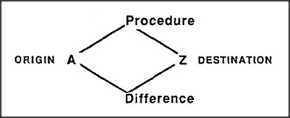


Much of ordinary thought is based on recognizing differences. This is because it is generally useless to do anything that has no discernible effect. To ask if something is significant is virtually to ask, What difference does it make? Indeed, whenever we talk about cause and effect we're referring to imaginary links that connect the differences we sense. What, indeed, are goals themselves, but ways in which we represent the kinds of changes we might like to make?
It is interesting how many familiar mental activities can be represented in terms of the differences between situations. Suppose you have in mind two situations A and Z, and D is your description of the difference between them. Suppose also that you are thinking of applying a certain procedure P to the first situation, A. There are several kinds of thinking you might do.

PREDICTING. To the extent that you can predict how various P's will affect A, you can avoid the expense and risk of actually performing those actions.
EXPECTING. If you expect P to produce Z but it actually produces Y, then you can try to explain what went wrong in terms of difference between Y and Z. EXPLAINING. If actions like P usually lead to differences of type D, then when you observe such a D, you can suspect that it was caused by something like P.
WANTING. If you are in situation A, but wish to be in a situation more like Z, it may help to remember ways to remove or reduce differences like D. ESCAPING, ATTACKING, and DEFENDING. If P causes a disturbing type of difference D, we can try to improve matters by finding some action that counteracts or opposes P. ABSTRACTING. In many forms of thought, the differences we notice between objects at each level become the objects of our higher-level thoughts.
Not only are differences important by themselves; more often than we realize, we think about differences between differences. For example, the height of a physical object is really a difference between the locations of its top and its bottom. And this means that the higher-level agents in our Societies-of-More must actually deal with differences between differences. For example, the agent Taller has to react to the difference between two heights — but as we've just seen, a height is already a difference between two locations!
The ability to consider differences between differences is important because it lies at the heart of our abilities to solve new problems. This is because these second-order-differences are what we use to remind ourselves of other problems we already know how to solve. Sometimes this is called reasoning by analogy and is considered to be an exotic or unusual way to solve problems. But in my view, it's our most ordinary way of doing things.